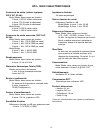
MODE SWITCH (4)
This switch is used to change operational modes of the amplifier. When the switch is pressed in,
the unit is placed in bridge mode (bridge mode is explained later in this manual) and uses only the
Channel A input. When the switch is out, the amplifier operates in stereo mode utilizing both inputs.
Accidental selection of bridge mode from stereo mode while the unit is in operation could cause
severe damage to loudspeakers, particularly biamped systems.
DDT SWITCH (5)
This switch is used to enable or defeat the internal DDT
™
compression circuitry. Normally the DDT
function should be enabled to minimize the possibility of either or both channels going into clipping
or overload. With DDT defeated, a severe overload could cause the mains fuse to blow as a matter
of course. (DDT is covered in greater detail later in this manual.)
POWER SWITCH (6)
This switch is used to apply power to the unit, thus turning the unit on. Use the status indicators (1)
to verify the actual power condition of the amp.
COOLING VENTS (7)
These vents provide a path for airflow. Since the DPC 1400X is a fan cooled device, it is very
important not to cover these vents or obstruct the flow of air in any way.
BACK
PANEL FEA
TURES
CHANNEL INPUT (8)
This input features a combo connector that will accept a standard three-pin male XLR, 1/4" TRS
(Tip-Ring-Sleeve), or 1/4" mono plug. An electronically balanced input is available via XLR and
1/4" TRS use. The unit is internally wired for the following:
Input
XLR TRS
(+) Pin 2 Tip
(-) Pin 3 Ring
GND Pin 1 Sleeve
Unbalanced input is achieved by use of a 1/4" mono plug (patch cable). It is best to keep the
cable from the output device to the input of the DPC 1400X as short as possible during unbalanced
operation.
INPUT THRU (9)
This TRS 1/4" jack is used to daisy chain the inputs of the DPC 1400X to the inputs of other power
amps or devices. Once again, short patch cables are highly recommended to minimize hum.
BINDING POST SPEAKER OUTPUTS (10)
Because of their high current handling capabilities, the binding post is recommended over the
standard 1/4" connector. For this reason, one set of binding posts is provided for each channel of the the
10 10 7 12 13 8 9 9811 11
4


















